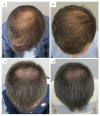Autologous Platelet-Rich Plasma (PRP) for Treating Androgenetic Alopecia: A Novel Treatment Protocol Standardized on 2 Cases
- PMID: 36555943
- PMCID: PMC9787984
- DOI: 10.3390/jcm11247327
Autologous Platelet-Rich Plasma (PRP) for Treating Androgenetic Alopecia: A Novel Treatment Protocol Standardized on 2 Cases
Abstract
Platelet-rich plasma (PRP) treatment has emerged in recent years as a valuable, effective, and affordable treatment for androgenetic alopecia. Androgenetic alopecia is the most common type of alopecia, affecting both men and women, and is characterized by diminished hair follicles mainly pronounced in the frontal region and vertex. A considerable variety of PRP treatment regimens have been described so far, but there is no consensus on the standardization of PRP preparation or administration protocol. Our study was conducted on two patients to test the efficacy of a new PRP application protocol of only two treatments by using a combination of a PRP collecting device and a conventional kit. Efficacy of treatment was assessed after a 6-month follow-up by artificial intelligence (AI)-driven software on microscopic images of treated regions. An average number of hairs, cumulative hair thickness, and the number of follicular units increased in the vertex region of both patients by 30/59%, 35/53%, and 14/48%, respectively. The novel treatment regimen showed significant effectiveness in only six months.
Keywords: androgenetic alopecia; hair follicle; hair loss; platelet-rich plasma.
Conflict of interest statement
The authors declare no conflict of interest.
Figures




Similar articles
-
The effect of platelet-rich plasma injection in the treatment of androgenetic alopecia.J Cosmet Dermatol. 2019 Dec;18(6):1624-1628. doi: 10.1111/jocd.12907. Epub 2019 Mar 20. J Cosmet Dermatol. 2019. PMID: 30895745 Clinical Trial.
-
Alopecia and platelet-derived therapies.Stem Cell Investig. 2017 Nov 14;4:88. doi: 10.21037/sci.2017.11.01. eCollection 2017. Stem Cell Investig. 2017. PMID: 29270414 Free PMC article.
-
Autologous activated platelet-rich plasma in hair growth: A pilot study in male androgenetic alopecia with in vitro bioactivity investigation.J Cosmet Dermatol. 2021 Apr;20(4):1221-1230. doi: 10.1111/jocd.13709. Epub 2020 Dec 2. J Cosmet Dermatol. 2021. PMID: 32888247
-
Platelet-rich plasma for androgenetic alopecia: Does it work? Evidence from meta analysis.J Cosmet Dermatol. 2017 Sep;16(3):374-381. doi: 10.1111/jocd.12331. Epub 2017 Mar 13. J Cosmet Dermatol. 2017. PMID: 28296142 Review.
-
Treatment of Androgenetic Alopecia Using PRP to Target Dysregulated Mechanisms and Pathways.Front Med (Lausanne). 2022 Mar 16;9:843127. doi: 10.3389/fmed.2022.843127. eCollection 2022. Front Med (Lausanne). 2022. PMID: 35372424 Free PMC article. Review.
Cited by
-
Decades of Scientific Data and Global Media Reporting on Complications in Non-surgical Aesthetic Treatments for a Transparent Safety Profile: Kissing Snow White Awake.Aesthetic Plast Surg. 2025 Jul 1. doi: 10.1007/s00266-025-05007-3. Online ahead of print. Aesthetic Plast Surg. 2025. PMID: 40593115
-
Systematic Review of Platelet-Rich Plasma in Medical and Surgical Specialties: Quality, Evaluation, Evidence, and Enforcement.J Clin Med. 2024 Aug 5;13(15):4571. doi: 10.3390/jcm13154571. J Clin Med. 2024. PMID: 39124838 Free PMC article. Review.
-
Mitochondrial Transfer from Human Platelets to Rat Dental Pulp-Derived Fibroblasts in the 2D In Vitro System: Additional Implication in PRP Therapy.Int J Mol Sci. 2025 Jun 8;26(12):5504. doi: 10.3390/ijms26125504. Int J Mol Sci. 2025. PMID: 40564967 Free PMC article.
-
Impact of Hair Transplantation on Quality of Life.Aesthetic Plast Surg. 2024 May;48(9):1825-1830. doi: 10.1007/s00266-023-03781-6. Epub 2023 Dec 20. Aesthetic Plast Surg. 2024. PMID: 38123846
References
-
- Piraccini B.M., Alessandrini A. Androgenetic alopecia. G Ital. Dermatol. Venereol. 2014;149:15–24. - PubMed
Publication types
LinkOut - more resources
Full Text Sources
Research Materials

